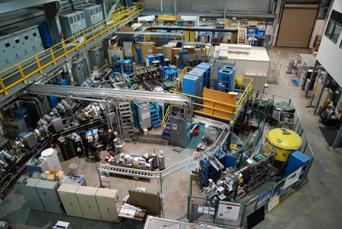TRIUMF's flagship nuclear-astrophysics facility known as DRAGON has set a new record for ultimate sensitivity—distinguishing between haystacks with needles in them and those without. This success clears the way for a detailed physics experiment that will study part of the process by which the Sun produces neutrinos.
A test run of TRIUMF experiment S1227 was completed successfully on 23 September 2010. The aim of the experiment is to measure the rate of the 3He + 4He -> 7Be + gamma radiative-capture reaction as a function of energy. In simple terms, this reaction combines two isotopes of helium into an isotope of beryllium with the emission of a photon or gamma ray. This reaction is important both because it relates to the production of solar neutrinos through the decay of 7Be and because it is the means by which 7Li was created in big bang nucleosynthesis in the first few minutes of the universe.

The experiment is mounted at the DRAGON recoil separator, where a beam of 4He isotopes bombards a 3He gas target. The 7Be fusion products are separated from the incident beam and detected at the focal plane of DRAGON using a position- and energy-sensitive silicon detector. The reaction is very improbable at the energies of astrophysical interest, so the recoil separator must simultaneously collect the fusion products with minimal losses and very efficiently stop the primary beam from reaching the focal plane where it would overwhelm the detectors or complicate the identification of the fusion products.
In this preliminary measurement DRAGON set a new world record for beam suppression. Although approximately 10^17 helium ions bombarded the gas target, not a single beam ion was observed at the focal plane. This implies a beam suppression capability of at least 10^17, which is at least a factor of 100,000 larger than has been demonstrated at any other recoil separator.
This experiment is especially challenging due to the current shortage of 3He, an isotope with a very small natural abundance that represents only 0.0001% of natural helium. The burgeoning interest in 3He for use in radiation detection systems with homeland security applications has rendered the isotope difficult to obtain for scientific purposes. We have now successfully operated a 3He recycling system capable of conserving our precious sample of 3He for continuing measurements at DRAGON.
-- By Barry Davids, TRIUMF Research Scientist
